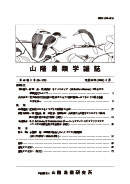Volume 45, Issue 1
Displaying 1-7 of 7 articles from this issue
- |<
- <
- 1
- >
- >|
Original Articles
-
2013Volume 45Issue 1 Pages 1-8
Published: September 30, 2013
Released on J-STAGE: March 24, 2016
Download PDF (934K) -
2013Volume 45Issue 1 Pages 9-38
Published: September 30, 2013
Released on J-STAGE: March 24, 2016
Download PDF (25213K)
Short Notes
-
2013Volume 45Issue 1 Pages 39-45
Published: September 30, 2013
Released on J-STAGE: March 24, 2016
Download PDF (652K) -
2013Volume 45Issue 1 Pages 46-52
Published: September 30, 2013
Released on J-STAGE: March 24, 2016
Download PDF (551K) -
2013Volume 45Issue 1 Pages 53-58
Published: September 30, 2013
Released on J-STAGE: March 24, 2016
Download PDF (341K)
Report
-
2013Volume 45Issue 1 Pages 59-64
Published: September 30, 2013
Released on J-STAGE: March 24, 2016
Download PDF (6685K)
Obituary
-
2013Volume 45Issue 1 Pages 65-66
Published: September 30, 2013
Released on J-STAGE: March 24, 2016
Download PDF (1406K)
- |<
- <
- 1
- >
- >|
